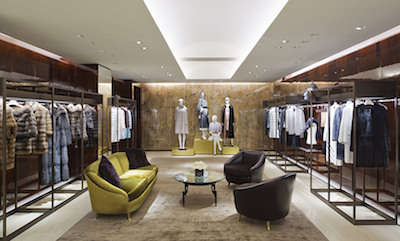Bricks-and-mortar department stores have failed to catch up to pure-play online retailer Net-A-Porter, with the ecommerce site outperforming them in online operations, according to new research from ContactLab and Exane BNP Paribas.
With added pressure from earlier moving ecommerce ventures, U.S. retailers were expected to ramp up their digital efforts to reach the same level as these digitally native retailers. While the retailers with a physical presence excel at connecting online and in-store, they fall behind Net-A-Porter when it comes to online-specific service.
"Net-A-Porter is digital native and is extremely consistent in assuring a top luxury performance in the majority of the more than 100 digital and physical touch points we have been evaluating along the online purchasing process," said Marco Pozzi, senior advisor at ContactLab. "Strangely U.S. department stores came out better on the digital touch points—in particular Nordstrom and Saks, while are average or lagging on physical touch points.
"It should not be difficult for department stores to improve packaging, fillers, documentation and overall care in order to give a more luxury and less Amazon like feeling to online customers," he said. "Of course this requires focus on the problem, and for sure additional costs."
After investigating the services of luxury brands in Milan, ContactLab has shifted its sights to the United States. “The Online Purchase Experience Ranking: From Milan to New York City” ranks 31 monobrand and five retailers based on the process of buying via ecommerce and returning items in New York.
Selling service
Net-A-Porter, the only etailer in the report’s rankings, began selling luxury goods online in 2000. Its early adoption of online selling continues to pay off, with the report placing Net-A-Porter in sixth place, with its closest multi-brand competitor Saks Fifth Avenue in 13th.
Nordstrom follows at 18, Barneys New York comes in at 26th and Bergdorf Goodman comes in second to last on the entire list at 35th.
Across the entire sample, ContactLab and Exane BNP Paribas found that the variance in scores given to each brand is lesser, showing that the outliers are beginning to catch up to the more advanced digital marketers. When compared to the assessment made in Milan nine months ago, ContactLab found that the rankings were very similar for both physical and digital touchpoints.
Balenciaga, Fendi and Saint Laurent sit at the top of the rankings, reflective of the dominance of boutique labels over mega brands such as Louis Vuitton. Gucci has remained stable, while Burberry and Prada go against the trend with slight improvement.

Fendi store on Madison Avenue in New York
When comparing luxury groups, ContactLab and Exane BNP Paribas show Kering in a positive positioning as it makes improvement in online selling while other conglomerates have more mixed progress.
"Balenciaga, Saint Laurent and Bottega Veneta all benefit from the elite excellence in digital processes and supply chain, a clear accelerator not only in Europe and the U.S., but above all in Asia.
"Fendi, the last major luxury brand launching the ecommerce channel, has been able to engineer a superior and coherent experience on both digital and physical touch points," he said.
"The task is more difficult for mega-brand like Louis Vuitton, Gucci, Hermes, Burberry, Prada, which generally must adapt older and somehow more rigid software platforms. In addition, the pace of change in big organizations is always slower."
In New York, luxury brands’ digital experiences were generally more advanced than they were in Italy. For instance, both Tod’s and Bottega Veneta offer a quick buy option at checkout in the U.S., enabling shoppers to place an order without registering for an account, something their European online stores require.
Some key areas where brands can improve are their abandoned cart communications and packaging.
Other best practices revolve around communication throughout the order process. While most index brands provided prompt replies to customer service emails, some including Cartier and Gucci never responded.
In addition, few brands provided information about the packaging as the order was placed, a best practice outlined by the report.

Dior gift packaging
When it comes to returns, Burberry and Cartier top the rankings in service offered, and the majority of department stores rank high. Most brands institute a window for returns, with Nordstrom standing out for its unlimited time to return.
While most returns are free, some brands charge a small fee.
Increasing importance
Ecommerce is going to be the major growth driver in the luxury industry for the foreseeable future.
Seven percent of personal luxury goods sales are made via ecommerce today, but online retail will represent 12 percent of the luxury market by 2020, according to projections from the Boston Consulting Group (see story).
ContactLab and ExaneBNP Paribas project that ecommerce’s penetration of the luxury market will be even greater, representing 15 percent of sales by 2020. In the United States, ecommerce’s position within the luxury industry was already at 12 percent in 2014, far higher than the 4 percent average across the rest of the world.
Every step in the purchase process goes into brand perception, making customer service and presentation paramount.
Consumers buying luxury goods online are more apt to pay extra to ensure a package’s on-time arrival than those purchasing other products.
While 84 percent of luxury shoppers said they would shell out more for on-time delivery, only 67 percent of all consumers said the same. As a survey by Dotcom Distribution finds, luxury clientele has higher expectations of the ecommerce delivery service, making fast shipping, packaging and communication key to winning repeat business (see story).
"I believe it is mostly a matter of focus and priorities," Mr. Pozzi said. "Too often the digital agenda is fragmented across too many functions—ecommerce, CRM, marketing, IT—and a formal and shared digital dashboard is missing.
"In addition, some brands still resist in shifting the budget from physical to digital," he said. "Last, even if not digital native, CEOs should always be somehow in charge of the digital agenda, and shareholders should push for this if they are reluctant."
{"ct":"ijT\/ito7Jq4m4gedKR22AD+Xp0zsQgXFPDcXhw5sU72Vt8PyGu6Fo3yR+nm5F\/BZJcyi7zVsrIz9G9\/Oryt+4LXQ57V+TarfRjuCMIMohR3hrdlCqt9PyGjZlQacn\/yqyqVMtQbfPIlI4qzizRo0ajVzNLJxU\/BNDO8vyTDGoLT9K2KfrX1LHMa2IiodHoQkQ+FUPeG\/E8qBRdxk2VrnEbAYK5f\/rvND02mXRv3anP6Kh1jdSz+C1AjauSHj4GM72IKOBgNWZxnpR9Dm5DHiaSYR2ZteHdRLoxNWzfzvONuuhfvGlqui+P15oBsqDNSMFWRWRMKsvD6+ZJ+VMoccU6sV+xnWasB\/k8EXbP+kYz6w9FK3LdUL4pOShqJbaVYlD9FqWOUCIgvnTbY1rvgBrNzEKkElIloP2Kp4zl0NWCMabcqifCDbKAl\/7x4bM4oG9wX6hpBSnzDW4O5IG7rdFN+mzT\/YtrhLol\/khX1pGFFg6JU2ScDHWlhnY3X80AlzQRpp4FpAIOkvdUAYqKjvZdV8QQgEWaAgHtVDj7bXVhOUUSsKlQzQiLt6RndKxHwqiB0zzF4KJYDfdaNOqqK++Mt8nnaI\/Oh3HaGjX91rCi0T7kuoViLgRa0Ta+RPgfvBkz\/5iJrtrI7h3n\/CINtp7GRNvMEnWpT7V0N7UbKMX2aKFyj3hipVmynU1ZOSvW4yajYpTcvpU\/8dtK8doBSIMm203t6ZYmGg\/FyAxmBvLfjWeMAoj1dC8NiLQpBpYtKYAqHcYww027labAl8FsQLHJ1DyuW1tB6P\/LDGeD4CCfNXYGX73qbUqt5BPu4oPoYdoK7Q597EixnvqcZfyEjLVwqACugBCbajAdrFyfxoLH9jjmp87SMsZbSnU7z95dwBm\/V0Ilfq\/Z7nlUNsCQnpo9cTn0ZUd5eGemkZscB+thso1\/pWbgAi5tixlXzVZ5ejrwcsh9DuxUJ8MNL48RugPHmS43kh+fIjm0NFjNIFqfg59F\/3a95RzmqOIm\/qoTq8G4xfu1r99mjmdnbqvTGU4eU1rYngW3O2\/Lcuf9qrykWf8FvKBxyVOq+TnAt+UOiZEXr4jjSanLTJafWAh9N9TA2o2CR1OYwgzPI33a6WvUvyOnopTAwlGqLmCEvXQ4Qlb88m74p7n5U1SH0d8I5HaX50e+yzWlTYOtxVPVCwTMYDNfj+BZ7TbEEPE1g0u2T8WPSktYwsdZGEJvVTcEuP0pSN0i8Cl0AxCeDZrm28OWE8dnSQL++qNHaaJmG6OvHwPKxBh2c6TYKElDn8SPFIOrslWWc5EH2zIXL+laN4LsqobXOwkKJvopXMVv2lSUMX7dj6wacMfB0qFYqPAdNAScgS3mFe+jPxYOG\/c1x5xZxog375mJt+u3a22L3xwbydbl53b7o+bgTnFW\/l\/pDxuguxDX\/wVGiVcitx2p8gTq31Rx9LwVdvgGxUo+5RvfRI6eJJ2bDjvZJ+JXr4+AsEPfKBAUbUBKxG0RgLvwlhj2sgzGM6FRzXhk+LmOzVjgenXqXWrvmDY1zsUPHukq3XCWnRbcBz0\/LygYw0PktzKZsBWhGf2s\/Dpp605T5VNqfdwi6A07SY5G66gPMgfr5413JLZIsQB1xjXDIm71mS1ZcAq4kLh6udFWzRrOwgAazjG66HYk+0mfSOo+xwGVVbwDaWSq0ZtbmDt+uzCk+VXH6\/ZezCBWAnMoWeLS27v3x6D\/3JxViFeeaud6ghD+w\/6R9u+T+CzyT3lfJ2iZw7+Y6KL9Gf2SAKdYnLjs8fTUE512uVF3wT2RtB5UTKhetwu+Sdd1nfYXryhxP6v0M6TTx4umsKszhVUg2ZN0RP1Nmf9ovdECzcx3PT0eMootjYd600qXI\/17xgyZpb8KhAlrdSzHVZbBEOrQsRfkemIWO9K\/TWWJGh+9Fn89qH88TGwcHEkJwJNM90mTtbtI9\/X3eNW896o041Tv3lfGJV3CJIgHvLvO+1s5iUyacXaJw5v62gGKZWGQxUlF9klBmIFOurkZAmDuePpzSMz4gfcZZfN3Obx66dqtbyCTrSiOut2+i2NR1bqzOynzekArhKOWJQ+EtmQpo+DFB9W3JAo7jRPoHDzh8k7MfWv3mkJhj8QG5o9L+WoqPxS8NtwMVYHPjKuk6b6xNil7hyaMYnTh0qFxwNBAdn1GW15mITm8AsQZJcdT9FgXov0GhpPrSvRdcV0BeAzx1qP7gyBa25XGu+9b+2ZKztdIwFkNhI91anD5w\/Msxc8QeM1ayuIZZuEFn8ZjrLx4IQ165extMk+JTswgm99HV1dD6+mGD0Bmu\/f\/\/b1TE7Hj22JQFnMTmbciIlNdpWOEHd39A3klFKS5ECd8u+I+aSHBMpAo26MYBqlz4Vt+zIP2NwNErp0OcvIZeXIefkkq1wa9KheI\/UrIk16nqFMJsV7eW8yuQDtirh\/2aC7ktxZS6kQHlKrClO9ih3JxbiwoMtXlnJ+cyhFoayKt0hc4mot85kwkfbjwxumKoJ+4ZVK7yzq89xvfUy4S5vkl\/HSucJrFSoqCfysGcP8cvUHmy6I3sTJBmPGg69sa+0gUGhN2cRmzZeJeAJUGPfjDXh1c8knzd\/OASjGpbRseUPsfaFqmBH\/iX+KfyDIwf+nYZFU91RxCmB95WWU6gUdNFX1oDASGC5MzwENFk4vv\/oONX0O2AdbmYXMIowK8epeYhV2cRTI6nnrahPNs5lVysgSVozCeX7ZevYFoTWdv0Vgfvy0KUJAO0N6N+8rDKbgyDdfFVPnA5ZNP6pVRxFm+Oh3uuCjfh+tAQxgEm5FQzJOtmPxtZs97HN4Oe+57hAnl1oj01Y4+r5wq3Lorf6Eqd\/hNgWI5L2DFvk2fs79GJt\/bbW9CzeKGqtS9M8TYYpaGHBD4fbmwYifkmWCJT9GWhonr1QrbWS8\/A7mx5WYJQqgyAn5pieaNDFrYPdJOWCyyUxcb+TWdyZnKAw7fiPxxnDFOWcfbTTY8a3ZlWXN0Zo5usUuKt0wz3Y+3xDrx9IEt\/IqEvSbDooszWDb5goY21BTi\/qtiq+sUsXcn09UbIt7srrQG63IcgqdGaY7Zd\/pUrEObveRedoaagHC7kxgRo3qtsNE22WnjQSvssfiLC\/jn\/Yak6l7KSgx1DDLXDI+YjHyWsf+sfqP9SpdReE4pMYFnMPyWo7HXSoaQq9nmOwVQDo4nrerso08jZZa9W4s+2K69HoJLxL\/f1rMeaC0wtq7Ai8y4hvrcMM\/POopN\/drPi2z\/QiOnAnx+ueCOy57kRF8TOv9x3CHyVnBhn\/9mWi3jJvBtTpcma4VeGw20BZPGKtUKQIXEUh7dKaCPjXQd2ITZYGEs9EjETSaE41yvtxm466c25JApuWXVbsP3vECTVCbz7EpKNcIh8f44B22UbITxfdMaFHsLTUBbZzhcPRLA1ND\/xvFSNfrmXx\/aQfD89FzfEGRzmnz6mGYI9X\/V6USzY2jfWGc1R\/3NAbv5ycSY\/i4jYJmGK\/rUTV2U6Ex0lQo6yO3eotHqIdxtZRYozLgNK3K8PNwFaMDvRsHFhyAeAHr+1aFTYzxYHvFwvsA2WWj+25I2FSHNYUDVkP7khEhWUmhElpfDyApb1xSK+BqNqZ6Im+hJbi1Ldo3yAb1rzQnRsOzFCTpvhQc1qcGNgsAYtr7W3LYHnwVKxhmWj3Tuo\/GMcv4Hb9BT3tZb0K8SbZbtj000nf2u4nD7KY+aabEQu89oyG2Iw+C3BtwttKghnOy5f\/ga05XVWWt2jpGv2KPNuLtfnPfleX0y1HY7bILCass9xLMt0S8LlHIrOeyF7JrwOUiFd1XoJuoq9EMK\/ws8d3uS7i6qKOV3IvrJC\/9G8kCkI9CyOkE9TpwM5ynlbo+40nmiVJ7+llcd3+752XkpF\/Zk1k8ZPwVpPGCrf39ynZb\/Nwh66eBFMA\/ms5llXcy3Zh4c5hFlulwIQWKmSTWGP1N\/rFkDUL8CreUF38EY8NAJ0N\/LR7RiAP9eX6xmwB8XanSc8RzAzarNdRlgfzF0tqYK4EiBZKaRLq0tHfr6bcLsTuWe+FoKaR6LSEle3WQkeNwmGlEez1PJMjz1PHFMVm6qKZxKJ+ivl1yR1hPzTp3tN6OsXBjQzpJmAsRUsvL4g7Hpt9Koe+xtMfUwevb11yCJcY4huxfp\/p+iSJn1I1yJ1sVenmu6ZTuXa2sREpjjRE46yY911YmmVWlblDBgTyY5LIb3KEPKTnT8G3Vl9Y54DCHFnmgcUEvpkq168a4aPfBpkCeEASC0dkpmCDfAgmGQMLtajYWExdVRTWB0bi+M0fr\/iDNIo3gzYjruRgZOdooto4Vm8CLDFy7H73SC+19nMWkB6Wt1ibkgz4bu8wexrww0qDLuqXnp7hGM\/XTdzuj76+Lg0kd9End\/vFrb9mP5KrQKro73YpfpJS4UQslVYsFi4mjgdoMpkbBAWNnNQ224ms\/Ul45O3Jih1XtdZnL0w1iXzlg13e9cjpAMFm3Rw0bERhN+MYooRPN8OZNsbjn3b+mnYxVNubW5ooxTRI4adcoipuxYt+vDUnglLB5NhoI1egZpQvtxiZ2AKb2TjCnoyg0fxk6jVxqKPDFPrvKcliTcfEj4gYAFw9wD6Z7f9HQcDcgKc4hb1NLSHDQNeSiMsoHS3BZeH9GzGIOuN4EmJtiQaNqeeXYBctmePCsHox3bTBuwMwTIQDclLtKa+YvTXi8+rpSjoj82JShdrBaKnctpHoVXuqI6JnjCcYKWknvjK+2o8HnyCWrsz1bwWKy\/ufCUMUUoNIRo39HjyRUrkLvKxd5X35P6kp0m6Pl+yr7zRn\/euIt0k38gxgENSQeXkmuvcn\/58Qsv4y7sIUgv0wBf1W\/w4DsP15RUbgRxYogPmhZ2LETANNyDYjVsictkV25n3N\/gvI36pyQd2+N6oaxqNlJsshOsVhglePsLxB21EsoOJRr8EKbedV0kBc9dfzprCaF4H7dnfsuBYJKPbqzJpAoIuVyQiCiSEKje8CUF8+NfjuSv7nWpKIcbPVHZZBpTQWE0\/4e1tHVO2D8devwDdbyoWJ13radyc40phahbtOEohme5rxSxuGlKNqouSLUoAbw1PIs5yTb31kpCWw8FYvgMnjz\/b4KTf79ZGZB3kuB0dxNNskb\/jojO70gTc1yvzJEejSrYjJMqbiJRLuK4cJvVFfmZMYtdbmyPBsM4IEdga16cRCTdW\/KOCl2VgIqlzGJ4zcD+tvPpFz\/yjVs7tJY4HUQj7mBCFskGmXIoshJ59CQBzT9eG7MPxMyD6DZnRqRwlQxA1fUjdq35KIG1yUH2fDizZy+jgqIYo3daLvxey+Zh6NaHhJ623Rs3Bn0gpmbOgsqKcJXh2K2hk+G2p52\/JbWKO0h\/yULzkJ2DhKHtvo36mJmvo8I4dTfrG1RpGB5G4YN\/v3AiC6IMowng9BNZvCaWcnPuo7rMH1xq8Xwf7NKG5t\/Qbz8W01voRRLDJ\/7W7AhL+vxsu3iHp6SYM1PLpC0z2PCsCMhlLB9cETCHFZJO8CRUnZcZsHUK695xOrbDsElvs63vuHRZpJn6VNeXEBnBFTE\/HrLcus5R8Qj8+n+adNkZWgoMyqd0edlvXP2zeBuqFUiDG3OYR9j5N5igGCYY+ewl\/YY8x\/qrFgQoiMIdZoL4w0KHHHiCinMFZ1tkp5EG7WqinbuOXjLZKJSo\/4C4p54S2tJvd9zk2rIsXojHFU\/UBclJ4K9RDaH0IQ5sHoNklDWquFz0a5sJSRHAMcnjBc+L7+aJtTpx\/M8nqt4AVWVKJiP2ganxEfrnFbuJRzj8CoYuMkGE8TQwkwYso16feunzZMtGi1Vdr9mSRl1sk675u5ZQikLo5mx4QTpBCdLSRlhPlEZc1ax0Z4pWdo8ai7Megdi6Q\/iAfwJuQCoCmpzEGmJ4g\/\/wOpdB\/rlvqau0rmSxYRNV+dIFq+E+A0Q8CGtszGNPkBkDrtrq+hZjiXNTMNe7VgJTSdRd8XgJ25iPWfkVqwAjxOCLgP8GRG+I5FKw7KkT2t3P60IFSwsgNoFbbx7uxl36l1rZUE4E6GDxE88qgE8am2XfErBS0lRZmdO4AbKRI3kP0y3c3fOIuvReZt2v1Jiw+wyQa0fCowJ8kY66SGK53onhqRpi0jfHmCEKvmp3kFxzvQfqhDL3psmgVE99ewLD+27O0h5EOpZzmH\/RZ3z0egdHbW39qJCQ6hDuEOnNfCNNJzwECOduW6340HjvUD0xgqOfBA25D7mEF3ddRjHc1XrISxr8BiHMKbVYL9x7ZSN66bsBOI1eVKQtBAVywua84oqPHARD9duBnRUI2oeU9GN0kgfc54fiv7WmRLyegWfMbXxt3FnlyDloIeEZy\/khnQr377auNAZlY7bT6pNzMBfhUDbNbvsgK9FmU2vRlii0AVqpC7FAD\/rDdmt0Kh+KSmwpHp9UXkfbd0pfDNfkJWxngzvCI11QX4kwSDFIEdbgme1zql1doXCIwjgvtM9mV74W4v+sKS38TvVsueryAJLJPieRykqBxMPJf8kb5MyrhG5CaepVEwkK8Gi0JK0ktrWCVQ2Abis\/MbTZv6O3r9435YiGMOfmkSjtlHTurhZGHVWbjW09DGq+vok8abwjl579F8u31zJj9wiLjc8+QZ\/+tVtATTscP1TyDFE+so\/BnSsHhrapxH9+GYUzzjGeL6vSIZpYiG9QlrgIlZvqgXIb1dvv0n3qIsK5gB9cPcet1yhw6egtEjY4WXBx1pu+h5nQDAFLHUTMOWPmiLynyi5oJMe1oHkfMxcGBk+xAvPaaXZQDcTjxCJ94\/VaMqa8l4VHPXi++NqwDk8cGjAKvF9HypEbcJjnM85sjNiTU7NqRI1WqcCQrdHAK+aw9LiPV7L4WVzDWjJfSy8tuRwLB6trF\/aJ\/Aim0bjDua7woqBd019VGWpXg2ob2IY9oW6Jk\/8X6uQRlOjjI0Lz3ojoZpfAkwmHwOsCTDPdl35lKDVpxUUWL0IYVzHRgTef3Hv\/DxFe67OIduQsUIdexTgwk00f2p7RdyMJi+LJsvnFBcP6aUSV4m7iDZaUooNQSSSHtzjur08itxLvaJYUhAlGMAedDkA6V7\/GoZDkt8vzyjb2B6+e6SG3+BhPxVnIdRT63X3WEPvrhK04rEoEIw1w\/Ml8vV9dkSCEQvBjUBdAITh7QwB3S162CYDThJ7ytnz7\/6HPagW9Ef3K9kviiZRCAkyvzYS1EHy4N7\/rqvMgMdtg2e3QFop0IyNhDJK+pUCyFYwBle92nElckx1iIRAI6bbz3TjIj7RCOOCowAXi6UjXmD+LzS4GaDpV6MHuqGNN54Y7QxJ9uyN2EhY+fVEROd\/a9HPLcLybJyRbL3ykyaMv\/w4CK6jAj8a5AVlLYgGcGQL0cknsK3mRjuc6IDtcPb\/BlK0lAG279+zhGNqXpldHWXv35tHwZddkJDRethAeyVlfPJ0\/kJKH3oataGjflICWczrz6NCtr6K95cgcUrmYTUFc1jVMRPvbft8H+cpy7LScX9QmBJ6+Y4HM2Lbn1AEkiMSTKBYdJI8IcYQTj+bAoYz6Zi7VVgAfELgkyMUHPXg8TGvVclx5LdaZWfb4AKdBKO\/3m9k8vwpFBlKdJuewRmNqGu9o0wzmxn9NtC5zbQJM7DEBH2T0Jw7GWV9yoFZ5p\/lwOw1x\/VABCRaGqt1mwP2aBuE9J0cg9hkeb+ofvmUhNJu5mmOqlCgx3P17GWVA55zTrIz4CzXx\/gVlqH0Pu6tpVZ0Vs8DishC5GHDSrY9w2fQPwadIa9PbmuUpue6ssZnYEYepxchXnbemGT2rvga05D3Ow0U8pDQdPNKpxjkRO4kwlHuYMM77IRLkAFhNKNZeFTxY8k6f1Mj0BvFqZF4\/OeUGsqHw\/6o\/HfdYCK\/VUTzSgmjY4TKsyIom5bo0BHrxlz3VtCjDP3XkZHqeLw4to8ZxZf7EzCySZriHs2qTQsYIWkF4JZbt5GEXI2TLqnBABEi7Md8BB0R4vyQsbKbo4gkICDah9\/ocLAG7mO93aA2pwmjdBxWgnxUTL1Ul1hkDoqMxp4P0BIY\/BHG+05M3rlB4FShlNjSQwaGwcktOVES\/uFxt5KW271x2fdmOuXzAOGcv+TUGXH+\/4jL2j2s1cbHsVRKHJFXmu8LKuidVBUk\/PjIgNVmRpguWk5VZYXHu1FPHOsw5TcpdbCBKFLfX8Gfd+VXnxNIV3LmC0VWFS4MeXrTjJ9boDPgjGvbdYRqJ6PLacOMXfjiqwWEWlY5\/8\/1otM78LdV5ra0UuqAdHWiN2WMeZc2bWbUBij7BRyisaSHSwHZpV5sbCrYGkcVBXsxhqrZ8W9nn3J9lxmJLmg2LbRq0NYEGczKWFCUv3oSUS6lL3zmmaq52P97sV7rOxjc1OFyUI+7a4y1jDrT6eCLCiLMUTK6jgmiBKfRLg5KVtXQ\/\/LQmCFn1K1DyeR9lin2K6My3Sw3lutSoNqHThO81TkqsrabxPLR3SVErW+UcbsIyyeh9\/Wb7Ewvlf4u\/n3LZvdxmhOVD0cvPlpjlF3an2yBJ1fVHWxAZjiyJtjcxY6Y8+wOgOrSzP7Tm8sLjm\/eNKYzV9wzcTBDGBiZWvl1ksizI\/BRQFZtfc0yG3EgmXN4FxBGMfk3Vc7JA6JhEgnO9bsEwUOk8tJB2mbmF4f5A82FSmWoMp03XAkrqrRdGFYsaGUEgSr5gOmnR9CbmYO6SIaiqFJTczenxwWYz1ho0XOVbKhKDJwV8Y+tmhgzTxGJTcr1dlQsazmAX3Hw+crwD24xHlJCRskELB2ziA6JDi9bMb6FbF2hdmcgtZ07aslHIGb\/7Df5aPrvf2XGMbJbLMz0vV12P\/mgyWgxuMYTkYDXjDcw5n2c3W1CjZDH0UAPECI4Vtu0xd5KVm8ojEzr7wTjj14zocTfVnxRBI34PrTRbBk40ERSYOWm6ZU1OinkOPu\/V9zSn+fuCSBWmGvN9s6p1DFgjYpsMgAcAA+Si04Kl8wQiUEuL9rJSgvGGsb0\/dpx79RNOw72vsxzZlOoKCnAVvfEWTlR3myk+PuSrb8e+ZdOofejAbqsJIEu4cdLLLLRLt2Xv+FvZSZ24c+4nsW6khz8URvwQIZYfAqxB4zjvnPlrT\/\/590\/xa9tRag5zV4w++D+D+UDTuSjzom3iXtOTayuEixgKJ19V2wAj1\/oiBCyPktRm2PWDqhjGkZirdOETz61bJmrghwHqhGKvH2zUi6eUODOY17dFp5ZczX8gU+BEQtK0d\/laoszb\/j5x39kdBDZ+U\/cY5h2TqneiJgS2anCMDr1P0VO\/Bo4efa83FKzuhen7AiEnm3elucXVDlZY7HuxdMfVGv1yAt1c5CLopOENDGf6l6NMmdrAdzXiXqDv0XZFYMnoJMySNb8SstKMgfeMeojvlh+vW+3ZPpWVNvnyHrZfjEg0UOEgYrXRPBng5eZHhetMkJzcqE170Z56bFkd\/BncqwwdQVT+ZIcvTAMWk7r+d53diTYt190pWps3TobeSMthO7cRqce\/x+qChDjejNRSdsnZS2HeksWeO9Qgnl5DK4VGKVP9n8rZYgMvhiqnqIKnSkI9Za8h2Yv+\/V5QVENbRqEMxV3pAABQDGSRospA9rKn4fxD+00SJWicBqZ\/MHcawZU1sNjsKB6sJAMHCn684n7MEx1hOSZ5YvK0Ny1KycNdQZ9m0Pb0k+1qeArLt+ZlpQuiKQsXUSezUSEePwDOb+YWQiCJmq\/MKREXkmYFbZsjtNDZTnFp4sGDXAunFnUiLD2V8+13vbrefj9A2CTfaFmqjUsZWW+rU44Ro4eNEvHMyTWOCkhgHC4VFIfnRFZcpMVnuAcfjpIV8pSvLxrqAUiqK2RfjLQVF\/JL5cnV5\/cx88SD9Nmr+LImplnQ67XksttfizKkoEQ+vJd\/\/6RRpzv9R5MTOByKaxkjeU+MCQiVvcluaFC\/WKtsPlFtgVeEgaZW6+94x3TkqRjNKdormBHbtSvuMCjvwk7wTyqAB6ZdFI9PN3kGUNqJ5ZTKe3fTn6XTN28umPeZnEkLPKRRndJ5YOEYMEllmTB4zDmo9Qd+rEOcKClh0snK176f4iD5Ibei6XkYw01ihz0DxUqy3cluh7vInoZbQDnmzqcbtzIPXtb5yxvRZU2Qxpa9WEW89gDmj87ZNcmX\/gMjzsCCbm3ikJKz62gawdsgm6o9+QWnsgbIqC+j7+RJ5hUx54hPCCzR6ranjsFnYRQnuw7ILmdbGDC05vuVRIwRx0WGId\/g6tITb6DNlK2ANzoPvygrMTZB5pFSI3F4w7l9e7E\/NC6\/EBOWDR+ZvTva35lTAi6hi1izX4PsCQ1JK1lkDs2v\/23H1bHHZZ5TU6i4vYeekNkhp6b75tgW79LPFwSbEnDth\/9kSwg0sdMY94BdcWap1IPm49bO58YMmcJ+ihyMx4agJemCHN95xST9Moi1hQM3PJr8uIOe9zSj3f7Ok52qEoBj7446bMdvuHEY6e9jnTYRb93f8Ndwm5jHBgaPUi9DMYL67xmR4nX4RP5ygIBwIlcWGbqhLWYrNoXS+j4xI\/Wh27xULyWBhlF+yw3IEh7PneXlXzUWnFnp8PwAAf46AA\/Q==","iv":"7b3817afbaa989a393d3d7e423faf5bb","s":"cd579942d88b588f"}
